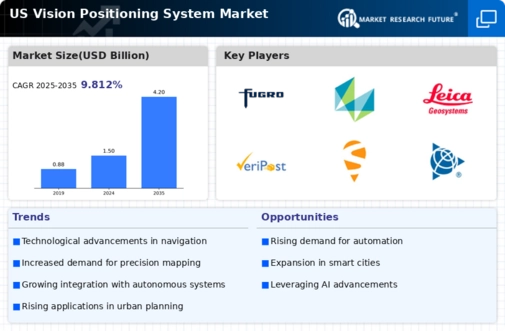Increased Adoption of Automation
The market is experiencing a notable surge in the adoption of automation technologies across various sectors. Industries such as manufacturing, logistics, and agriculture are increasingly integrating vision positioning systems to enhance operational efficiency and accuracy. This trend is driven by the need for precise navigation and positioning capabilities, which are essential for automated machinery and robotics. According to recent data, the automation sector is projected to grow at a CAGR of approximately 10% over the next five years, indicating a robust demand for advanced positioning solutions. As companies seek to optimize their processes, the vision positioning-system market is likely to benefit significantly from this shift towards automation.
Growing Focus on Safety and Security
The market is benefiting from a growing focus on safety and security across various industries. Organizations are increasingly recognizing the importance of accurate positioning systems in enhancing safety protocols, particularly in sectors such as construction, transportation, and public safety. The integration of vision positioning systems can significantly reduce accidents and improve operational safety. Recent statistics indicate that workplace accidents can be reduced by up to 40% with the implementation of advanced positioning technologies. This heightened emphasis on safety is likely to propel the demand for vision positioning systems, as companies strive to create safer work environments.
Advancements in Machine Learning and AI
The market is being transformed by advancements in machine learning and artificial intelligence (AI). These technologies are enhancing the capabilities of vision positioning systems, enabling them to process vast amounts of data and improve accuracy in real-time. The integration of AI algorithms allows for better object recognition, environmental mapping, and predictive analytics, which are essential for various applications. The AI market is expected to grow significantly, with estimates suggesting a value of $190 billion by 2025. This growth indicates a strong potential for the vision positioning-system market to leverage AI advancements, thereby improving system performance and expanding its application scope.
Rising Investment in Smart Infrastructure
The market is poised for growth due to the rising investment in smart infrastructure initiatives across the United States. Government and private sector investments in smart cities and connected infrastructure are creating a favorable environment for the deployment of advanced positioning systems. These systems are crucial for applications such as traffic management, public safety, and urban planning. Recent reports suggest that the smart infrastructure market is expected to reach $500 billion by 2026, with a substantial portion allocated to technologies that enhance positioning accuracy. This trend indicates a growing recognition of the importance of vision positioning systems in developing efficient and sustainable urban environments.
Emergence of Augmented Reality Applications
The market is witnessing a significant impact from the emergence of augmented reality (AR) applications. As AR technology continues to evolve, its integration with vision positioning systems is becoming increasingly prevalent in sectors such as retail, education, and healthcare. These applications require precise spatial awareness and positioning to deliver immersive experiences. The AR market is projected to grow at a CAGR of over 30% in the coming years, suggesting a strong demand for vision positioning systems that can support these innovative applications. This synergy between AR and vision positioning systems is likely to drive market growth and open new avenues for development.
























Leave a Comment